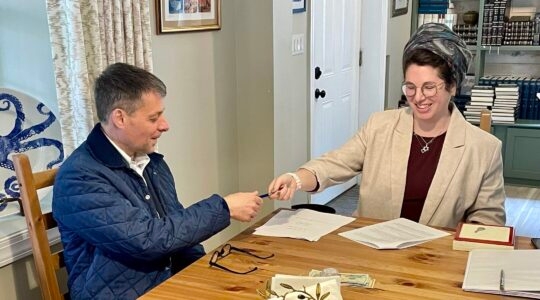(JTA) — On Jan. 16, 1949, Toby Fassman married Max Cohen (Steven M. Cohen’s parents, now both of blessed memory). At 24, Toby was among the last of her circle of friends in Brooklyn to marry, and several jokingly remarked that Max had rescued her from lifelong singlehood.
Today, if a 24-year-old Jewish woman were heading for the huppah, most would presume that she’s either Orthodox or reckless. Indeed, of 25- to 54-year-old American Jews who are not haredi, fully half are unmarried. While marriage rates peak around age 40 at 71 percent, they drop again to just 57 percent among those 10 years older. Of those 45-54, 13 percent have never been married and another 21 percent are divorced or separated.
These patterns of marriage — and non-marriage — are just a few of the startling findings we reveal in a new report published by the Jewish People Policy Institute in which we analyze data from the Pew Research Center’s Portrait of Jewish Americans survey.
Of course, the rise of singlehood, late marriage and non-marriage is not at all unique to American Jews, but is endemic to American society in recent years. As the Pew Research Center reports, “The share of Americans who are married is at its lowest point since at least 1920.”
But for Jews and Jewish life, the postponement of marriage or lifelong singlehood hold disturbing consequences for Jewish community. While intermarriage has long been understood as inhibiting Jewish engagement and connection, the same is almost as true of non-marriage.
Take, for example, synagogue membership among non-haredi Jews aged 25-54: It reaches a healthy 65 percent among the in-married, but only a paltry 22 percent among the non-married and an even tinier number, 13 percent, among the intermarried. While almost all in-married Jews attend Passover seders (93 percent), that’s true of just over half the intermarried or non-married (53 percent and 59 percent, respectively). And not only do the in-married act more Jewish, they feel more Jewish. Nearly two-thirds (63 percent) say that being Jewish is very important to them, as compared with just 40 percent of the singles and 25 percent among the intermarried.
All over the Jewish world outside of Orthodoxy, we see shrinking numbers and older participants and fewer young Jews involved in organized or institutional activities. That’s true of Reform temples, Conservative shuls, membership organizations and federation campaigns. And all the wonderful alternative innovations – independent minyans, Chabad Houses, Base Hillels, Moishe Houses, social justice initiatives, Israel advocacy left and right – are simply not anywhere near compensating for the losses in legacy institutions.
To understand why non-Orthodox Jewish activity at home and community is in such decline, we need only look at diminished numbers of young adult and middle-aged Jews who live with a spouse, and specifically a Jewish husband or wife.
Child-rearing strongly shapes stronger connections with things Jewish, even beyond marrying someone Jewish (by birth or conversion), in dramatic contrast with being single or married to a non-Jew. Those raising a child in the Jewish religion vastly surpass childless adults in Jewish engagement, and the childless in turn surpass those raising non-Jewish children.
Take, for example, synagogue membership: 65 percent among those raising Jewish-by-religion children, 25 percent for those with no children at home, and 0 percent for those raising non-Jewish children. We see the same pattern for seder attendance: 96 percent, 56 percent, 28 percent. And so it goes for one indicator of Jewish engagement after another.
In displaying a close connection between family status and religious involvement, Jews are not at all unique or even distinctive. Religious engagement has long been linked to life cycle. Americans — including Jews — increasingly join religious institutions and practice home-based rituals shortly after they have children. Sylvia Barack Fishman’s research found that intermarried Jews and spouses are often surprised at the strength of their feelings about religious identification after — but not before — their children are born. The baby boom of the postwar years occasioned a building boom of churches and synagogues. For Jews (and others), what is new is the extended years of singlehood and religious detachment, posing unprecedented challenges to Jewish families, communities and institutions.
So, recognizing that children – specifically Jewish children – are so vital to Jewish engagement, we can ask: How many Jews in the parenting years (25-54) outside of the haredi world are raising Jewish children? The startling answer is less than a third, and even less (21 percent) if we’re talking only about children whose religion is Jewish. Fully 60 percent of this 30-year cohort has no children at home and 8 percent are raising non-Jewish children.
What will it take for Jewish engagement at home, in the community, in institutions and elsewhere to thrive? Probably the most critical answer: Jews will need to start marrying, marry younger, marry Jewish spouses and raise Jewish children. Over the past few decades, among those Jews outside of Orthodoxy, the relevant trend lines have moved in the opposite directions: less marriage, later marriage, intermarriage and fewer Jewish children – probably about 1.4 for non-Orthodox Jews, far below the 2.1 needed for population replacement.
There are strategies that reverse these negative trend lines. It turns out that Jews who are more connected to other Jews through their adolescent and young adult years are more likely to marry, to marry younger, to marry Jews and to have Jewish children. Camps, youth groups, Israel travel, campus activities and young adult communities all build Jewish social networks – more Jews in relationships with more Jews.
These interventions of course contribute to Jewish cultural capacity and religio-ethnic commitment. But as important, if not more important these days, is that they build friendships that lead to marriage or romantic connections. Only by increasing the opportunities for Jews to marry, and to marry Jews, will we be able to significantly bend the trend lines. Creating more Jewish marriages and filling more Jewish baby carriages inevitably leads to seeing more Jews in the pews, as well as other places where Jewish engagement gets acted out.
We may not be able to move the average age at marriage below 24. But perhaps by providing opportunities we can increase the sheer number who marry and who marry at a younger age, when they stand a better chance of becoming engaged Jewish parents.
(Steven M. Cohen is research professor at Hebrew Union College-Jewish Institute of Religion, and director of the Berman Jewish Policy Archive @ Stanford University. Sylvia Barack Fishman is the Joseph and Esther Foster Professor of Contemporary Jewish Life in the Department of Near Eastern and Judaic Studies at Brandeis University, and also co-director of the Hadassah-Brandeis Institute.)
JTA has documented Jewish history in real-time for over a century. Keep our journalism strong by joining us in supporting independent, award-winning reporting.






